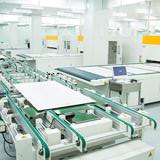

What is the difference between ink and surface printing ink? I don't know how to poke into it!
Print ink
In recent years, with the rapid development trend of the printing industry and the increasing level of packaging printing standards, the printing level and processing technology of various laminated glass packagings have also been continuously improved. The tempered laminated glass is different from the usual laminated glass packaging printing. The two are printed with printing ink, and the former is printed with surface printing ink.
Most of the inks in China are composed of 30%~50% binder, 5%~16% color paste, 50%~65% solvent and 0%~5% modifier. The coupling material is a bonding epoxy resin, which is a chain structure of the ink, and the color paste and the material to be printed are bonded together to adhere the actual effect and make the ink glossy; the color paste determines the color type; The organic solvent melts the epoxy resin, adjusts the viscosity, adjusts the boring rate, and improves the actual effect of wet and cold on the packaging printing material; the preservative improves the viscosity, the aging resistance, the anti-aging, and the gloss enhancement.
Incorporating the product development, manufacturing and customer application reflections of our factory for many years, the following is a brief analysis of the difference between printing ink and surface printing ink.
The difference between printing ink and surface printing ink
Difference in joint material
The key of the printing ink is polyamide resin, which has good adhesion and good gloss, but it is not suitable under high temperature standard. The color fastness is poor in composite type; the key of non-steamed printing ink is chlorine. Polypropylene, overseas also effective nitric acid chemical fiber and vinyl chloride - vinyl acetate copolymer epoxy resin. The heat-resistant steamed printing ink coupling material is a polyurethane material. When applied, it is registered to participate in a sufficient amount of hardening agent, and the two liquids are mixed to reflect chemical crosslinking.
Differences in common organic solvents
The key organic solvent commonly used for surface printing inks is toluene and isopropanol; usually the printing ink organic solvent is dominated by xylene and ethyl acetate. In the heat-resistant steaming printing ink, it is dominated by ethyl ketone and ethyl acetate. The printing ink organic solvent is suitable for idle packaging printing, and the organic solvent has a rapid volatility and a very small organic solvent content.
Wear resistance difference
The polyamide resin has good flexibility and high ductility. The enrolled modifier has good wear resistance and is strong against external blocks. The printing ink epoxy resin chlorinated polypropylene propylene epoxy resin has very good rigidity and poor wear resistance. Therefore, the printing performance is relatively low.
Different materials have different differences
The printing ink and the printing ink are different because of the joint materials, and the auxiliary modifiers and preservatives are different. The surface printing inks often sign up for moisture, kiwi fruit acid ester, which is used to improve adhesion and enhance gloss. Degree, increase the viscosity. Ink inks are registered to participate in various pigment dispersants, reinforcing agents, defoamers and other modifiers.
Differences in printing technology
The printing process is the same as the normal plate making process, but the image on the printing plate is reversed when the printing plate is printed, the inverted image is printed after printing, and the reverse printing image is inverted image, and the reverse printing is reversed. The printing ink of the printing ink is very slow, and the printing speed of the printing ink is faster than the printing. The packaging printing color sequence is also different.
Tel:15158365810
HTML:www.mysyqc.com
Add:No.185, bridge 3 road, xiaoqiaotou village, qiaotou town, cixi city